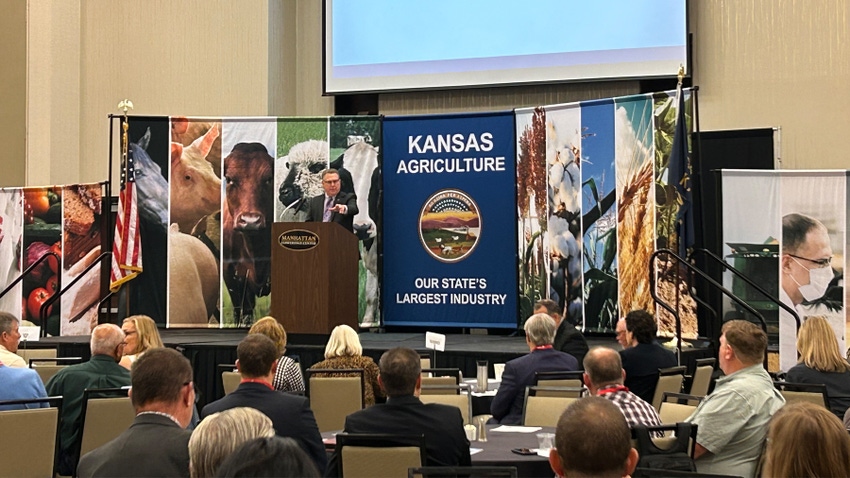
Water and labor. These two inputs are the top of every Kansas farmer’s list of concerns. Will we have enough water for future farm needs? Where will reliable ag labor come from if our communities continue to shrink?
That’s why in a change of format, the 2023 Kansas Governor’s Summit on Agricultural Growth set aside different sector breakouts, and instead chose to focus the day’s conversations around water and labor. Participants from every segment of Kansas farming, ranching, rural community, agribusiness and conservation interests gathered in Manhattan, Aug. 17. Fresh off the news that the state’s agricultural exports hit $5.46 billion in 2022, attendees were tasked with sharing ideas and innovations that could keep the state on trajectory.
“Water and labor affect every sector in our state,” said Gov. Laura Kelly. “We saw with the drought — how it starved our wheat at a time when Kansas and the world can’t afford it. The future of our water is existential. We can’t afford to kick the can down the road.
“It’s also no secret we have been creating jobs and bringing business to Kansas,” Kelly added. “One thing in our way is ensuring that we have enough skilled workers for the jobs we are creating. We’re expanding apprenticeships, and I want to thank Kansas Farm Bureau for working with my administration to get this done.” Overall, she added, making our rural communities places where young people want to return, to put down roots and raise their families, is critical to our future.
Water
Nathan Hendricks, Kansas State University agricultural economist, shared some insights into the value of water.
“This is tricky, because there is no open market for water,” he began. “It isn’t a private commodity to be traded. We can look at the cash price of corn, and find the value of a bushel of corn, but water isn’t traded. So, we don’t see the value of water in the same way.”
Yet, to make water management decisions, we need data, he said. And when the result of those decisions isn’t really seen until years, sometimes decades into the future, it can be difficult to get public policy passed. As part of his work, Hendricks shared some of the data points he’s gathered surrounding water use in agriculture:
Reviewing land transactions from the past 40 years, Hendricks estimates the value of access to irrigation under agricultural land has added $3.5 billion to land valuations. “We can also see in that data [that] the market does give a premium to those areas with more saturated thickness in the aquifer,” he added. For each acre-foot of saturated thickness decline in the aquifer, that results in a $4 to $15 per acre decline in land value per acre.
Hendricks found that fertilizer expenditures are 25% greater in those counties over the aquifer, and chemical expenditures are up 18%.
Livestock expenditures in counties over the aquifer are just over $200 million, compared to adjoining counties’ livestock expenditures at just under $50 million.
Hendricks said going forward Kansans must ask themselves: Are the benefits of extending the life of the aquifer greater than the costs of what it takes to use less water today?
And the more difficult challenge — overcoming the attitude of “I’ll reduce my water use if my neighbor does it as well,” he added.
Labor
Charles Conner, president and CEO of the National Council of Farmer Cooperatives addressed the labor challenge of today. Agriculture is a labor-intensive industry, and the tasks aren’t everyone’s favorite, Conner said. And while we need to do what we can to encourage our young people to return to our farms and ranches, he added, foreign workers are a critical part of our labor force.
“Whether you employ foreign workers or not, the people buying your commodities and transforming your crops into consumer products heavily rely on workers,” Conner said. And right now, if someone has the choice to work standing in a milking parlor or moving into the higher-paying construction, food, or retail sectors, they will leave agriculture.
“There is an estimated 1 million to 1.1 million workers on our farms and ranches doing our work who could not pass a legal E-verify test in America today,” Conner said. “They don’t have proper documentation to be in this country. That workforce is 60% of our nonfamily hired workforce on our farms and ranches today. We could not function if someone came and said, ‘They aren’t legally here, they have to go back.’ Our system would collapse.” Simply put, and without the political rhetoric, Conner said, we could not replace 1.1 million workers at any price in agriculture due to the nature of the work and the competition from other sectors for those workers.
Conner spoke about the H-2A guest worker program’s flaws and potential fixes that could help our farms and ranches of today, where the work is year-round and not seasonal. Today, 375,000 workers a year come into the U.S. on the program:
Make it year-round in statute. Farms today are diversified, so the work never stops.
Make it more useful for livestock producers — again, where the work is not seasonal.
Address the inequalities in the Adverse Effective Wage Rate that is meant to establish a minimum wage for H-2A workers. The rates, because of outdated regulations, can add $1 million for every 50 employees on an operation.
Cut the red tape — and, at the very least, don’t add to the red tape that’s there. For example, Conner shared that due to regulations, say you have a group of H-2A employees in a field hired to pick a crop. There’s a truck that needs to be moved. The employees cannot move that truck because it’s not in the defined job duties that they were hired for under that H-2A program. That’s a different category of wages, he said.
Create a “blue card program” that is exclusively available to agricultural workers. This program would ensure a labor force that is stable and not moving around and would provide a path to legal citizenship.
“Congress needs to do its job and pass ag labor legislation,” Conner said. “We need to protect workers already on our farms and ranches, and make H-2A more usable for the average producer. Almost 10 years ago, we had legislation that was passed by the U.S. Senate to fix the problem, but it didn’t pass the House that year.” It’s become a political talking point, Conner said.
About the Author(s)
You May Also Like






